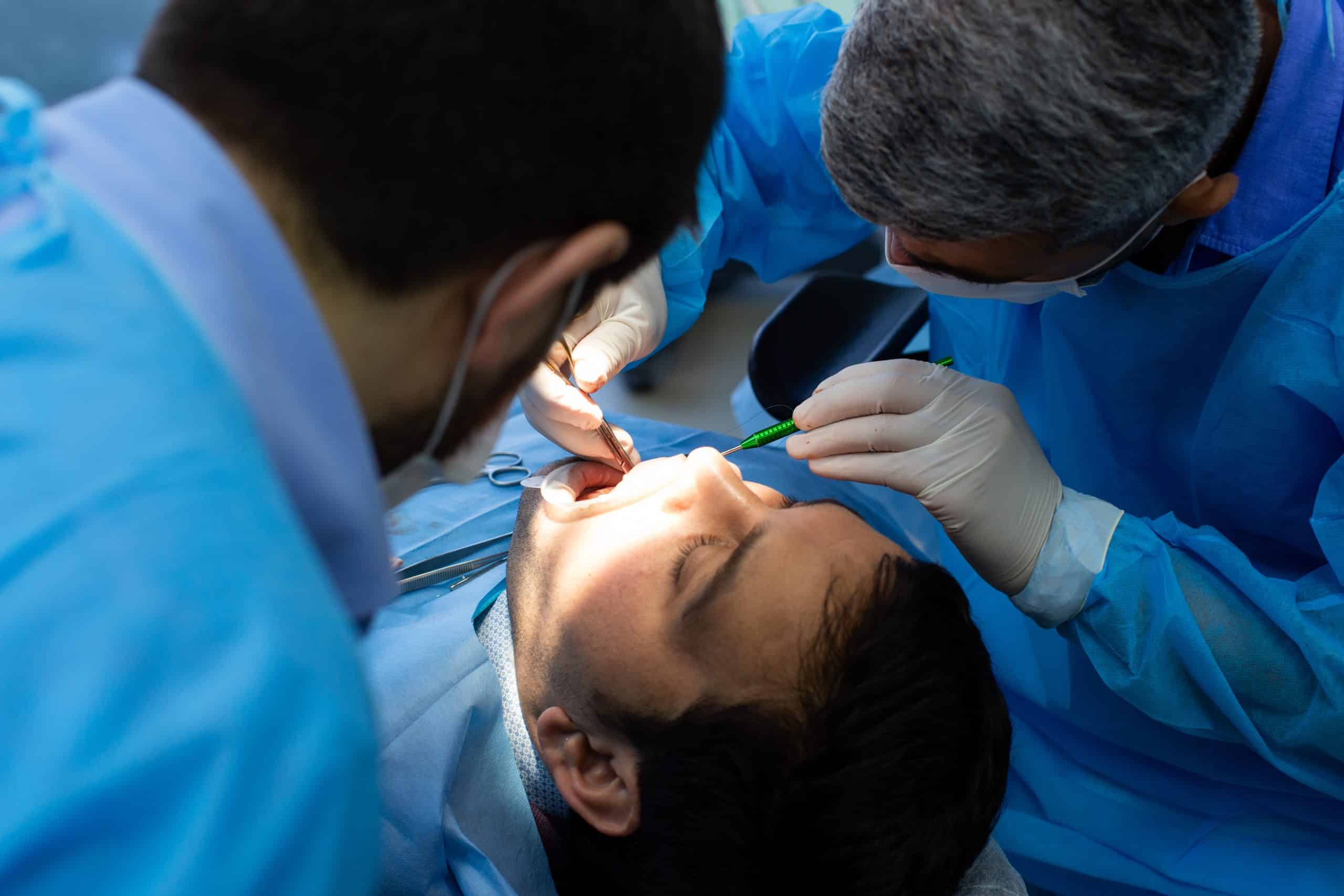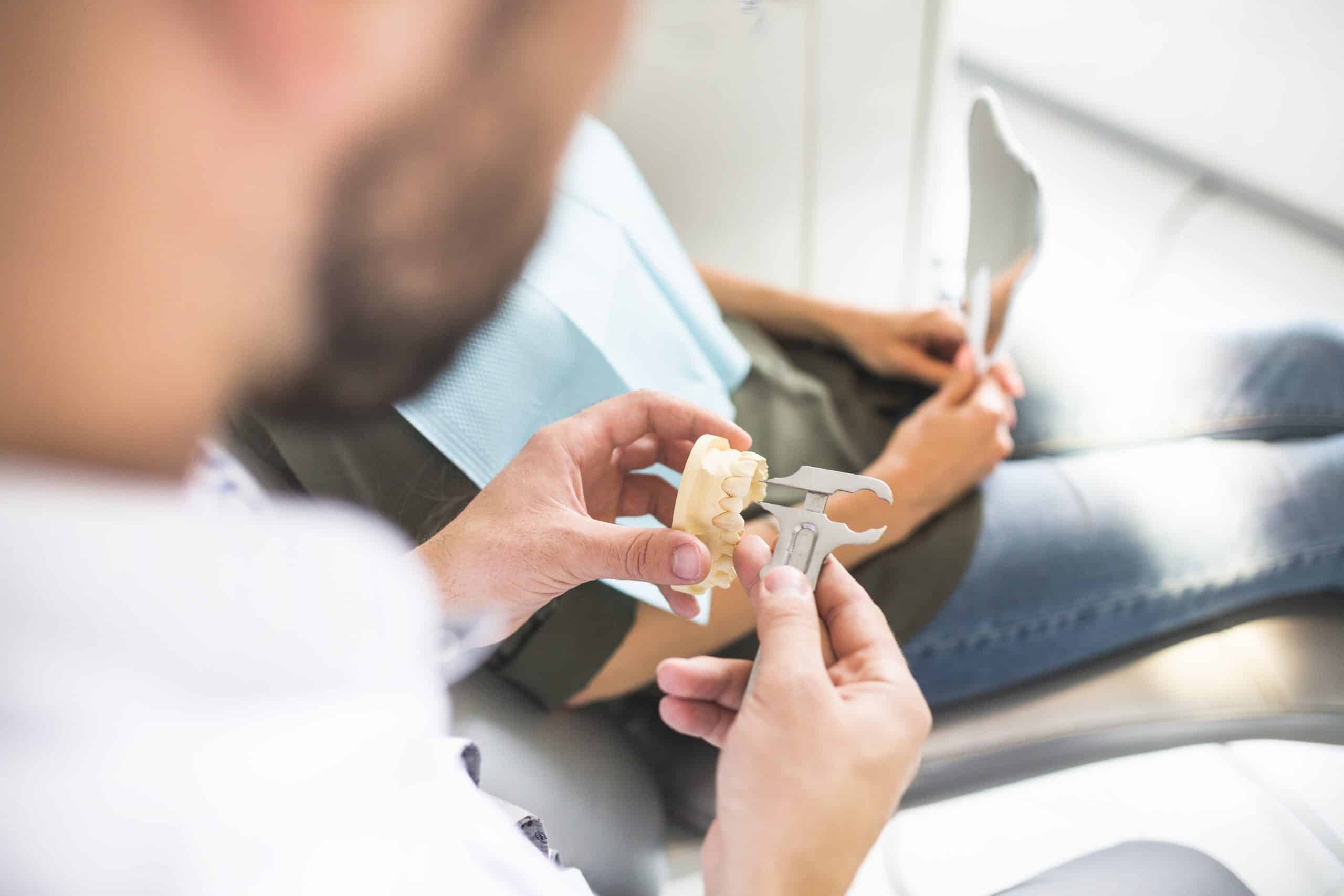Are you unhappy with the shape of your face? Do you yearn for a more balanced and symmetrical appearance? If so, you may be a candidate for maxillofacial and orthognathic jaw surgery, a procedure that can achieve jaw-dropping results.
Maxillofacial and orthognathic jaw surgery is a specialized procedure that aims to correct various facial irregularities and bring balance to the overall appearance. Whether you have an overbite, underbite, asymmetrical jaw, or other jaw-related issues, this surgery can harmonize your facial features and enhance your self-confidence.
The surgery involves repositioning the jawbones to achieve proper alignment and balance. By moving the upper or lower jaw forward, backward, or sideways, the surgeon can correct your bite, improve facial contours, and create a more harmonious facial appearance.
Performed by skilled oral and maxillofacial surgeons, this procedure has transformed the lives of countless individuals. If you are interested in achieving a more balanced facial appearance, consider consulting with a qualified surgeon who can assess your needs and discuss the best course of action for you.
Don’t let facial irregularities hold you back; take the first step towards a more harmonious and confident you with maxillofacial and orthognathic jaw surgery.
Understanding facial asymmetry
Facial asymmetry is a common concern among individuals seeking facial enhancement. It refers to the lack of harmony and balance between the different sides of the face. While some degree of asymmetry is natural and adds character to one’s appearance, pronounced facial asymmetry can be a source of self-consciousness.
Facial asymmetry can be caused by a variety of factors, including genetics, developmental abnormalities, trauma, or even lifestyle habits. It can manifest as a misalignment of the jaws, an uneven distribution of facial tissue, or a noticeable difference in the size and shape of facial features.
Maxillofacial and orthognathic jaw surgery addresses facial asymmetry by repositioning the jawbones to achieve optimal alignment and balance. By correcting the underlying structural issues, this surgery can create a more symmetrical facial appearance and boost your confidence.
If you are concerned about facial asymmetry, consult with an experienced oral and maxillofacial surgeon who can evaluate your condition and recommend the most suitable treatment plan.
What is maxillofacial and orthognathic jaw surgery?
Maxillofacial and orthognathic jaw surgery is a complex procedure that involves the surgical repositioning of the jawbones to correct various jaw-related irregularities. It is a specialized field within oral and maxillofacial surgery that focuses on improving the functionality and aesthetics of the jaw and face.
The procedure is customized to address each patient’s specific needs and may involve repositioning the upper jaw, lower jaw, or both. The surgeon carefully evaluates the individual’s facial structure, dental occlusion, and overall harmony to determine the precise surgical approach.
Maxillofacial and orthognathic jaw surgery is typically performed under general anesthesia in a hospital or surgical center. The surgeon makes incisions inside the mouth to access the jawbones, minimizing visible scarring.
Using specialized instruments, the surgeon repositions the jawbones and secures them in their new position with plates, screws, or wires. The incisions are then closed, and the patient is monitored as they awaken from anesthesia.

Common conditions treated with jaw surgery
Maxillofacial and orthognathic jaw surgery can effectively treat a range of jaw-related conditions that affect both the functionality and aesthetics of the face. Some common conditions that can be addressed with this surgery include:
1. Overbite: An overbite occurs when the upper jaw protrudes forward, causing the upper teeth to overlap significantly with the lower teeth. This can lead to difficulty chewing, speech issues, and an unbalanced facial appearance.
2. Underbite: An underbite is the opposite of an overbite, where the lower jaw protrudes forward, resulting in the lower teeth overlapping the upper teeth. This can also cause functional problems and affect facial harmony.
3. Crossbite: A crossbite occurs when the upper and lower jaws are misaligned laterally. This can lead to problems with the bite, jaw function, and facial symmetry.
4. Open bite: An open bite is characterized by a gap between the upper and lower teeth when the jaws are closed. This can cause difficulty with biting and chewing and affect the overall facial appearance.
5. Facial asymmetry: As discussed earlier, facial asymmetry can be caused by various factors, including jaw misalignment. Maxillofacial and orthognathic jaw surgery can help correct the underlying structural issues and restore balance to the face.
By addressing these conditions, maxillofacial and orthognathic jaw surgery can improve both the functionality and aesthetics of the jaw and face, enhancing the overall quality of life for individuals suffering from jaw-related issues.
Benefits of maxillofacial and orthognathic jaw surgery
Maxillofacial and orthognathic jaw surgery offers numerous benefits, both in terms of functionality and aesthetics. Let’s take a closer look at some of the key advantages of this procedure:
1. Improved facial harmony: By repositioning the jawbones, maxillofacial and orthognathic jaw surgery creates a more balanced and harmonious facial appearance. The procedure can help correct facial asymmetry, enhance the contours of the face, and bring all the features into proportion.
2. Enhanced self-confidence: Many individuals with jaw-related irregularities experience a lack of self-confidence due to their appearance. Maxillofacial and orthognathic jaw surgery can significantly improve self-esteem by transforming the facial appearance and allowing individuals to feel more comfortable in their own skin.
3. Better oral health: Correcting jaw misalignment can have a positive impact on oral health. By improving the bite and alignment of the teeth, the risk of dental problems such as cavities, gum disease, and tooth wear can be reduced.
4. Enhanced speech and chewing function: Jaw misalignment can affect speech clarity and make chewing difficult. Maxillofacial and orthognathic jaw surgery can address these functional issues, allowing individuals to speak more clearly and chew food comfortably.
5. Long-lasting results: The results of maxillofacial and orthognathic jaw surgery are typically permanent. Once the jawbones are repositioned and healed, the new facial harmony and improved functionality will be long-lasting.
These benefits make maxillofacial and orthognathic jaw surgery a life-changing procedure for individuals seeking a more balanced facial appearance and improved quality of life.
The surgical process of jaw surgery
The surgical process of maxillofacial and orthognathic jaw surgery involves several stages, from the initial consultation to the post-operative recovery. Let’s explore each stage in detail:
1. Initial consultation: The journey begins with an initial consultation with an experienced oral and maxillofacial surgeon. During this consultation, the surgeon will evaluate your facial structure, discuss your concerns and goals, and explain the surgical options available to you. This is also an opportunity for you to ask any questions or address any doubts you may have.
2. Treatment planning: Once the surgeon has assessed your condition and determined that you are a candidate for jaw surgery, a comprehensive treatment plan will be developed. This plan will outline the specific surgical techniques to be used, the expected outcome, and any necessary pre-operative preparations.
3. Pre-operative preparations: Before the surgery, you may be required to undergo certain tests or evaluations to ensure your overall health and readiness for the procedure. This may include dental examinations, X-rays, and possibly a consultation with an orthodontist to discuss any necessary pre-surgical orthodontic treatment.
4. Surgery day: On the day of the surgery, you will be admitted to the hospital or surgical center. The procedure is typically performed under general anesthesia, ensuring your comfort throughout the surgery. The surgeon will make incisions inside your mouth to access the jawbones, minimizing visible scarring.
5. Repositioning the jawbones: Using specialized instruments, the surgeon will carefully reposition the jawbones according to the treatment plan. Plates, screws, or wires will be used to secure the bones in their new position. The incisions will then be closed using dissolvable sutures.
6. Post-operative recovery: After the surgery, you will be closely monitored as you awaken from anesthesia. You may experience some pain, swelling, and bruising, which can be managed with pain medication and cold compresses. The length of the recovery period will vary depending on the individual, but most patients can expect to return to work and regular activities within a few weeks.
7. Post-operative care: Following jaw surgery, you will be provided with detailed instructions for post-operative care. This will include guidelines for oral hygiene, dietary restrictions, and any necessary follow-up appointments with your surgeon or orthodontist.
It’s important to note that the surgical process may vary depending on the complexity of your case and the specific techniques used by your surgeon. Your surgeon will guide you through each step of the process and provide personalized care to ensure a successful outcome.
Recovery and aftercare for jaw surgery
The recovery period after maxillofacial and orthognathic jaw surgery is a crucial time for healing and ensuring the best possible outcome. Here are some important considerations for a smooth recovery:
1. Pain management: It is normal to experience some discomfort, pain, and swelling after jaw surgery. Your surgeon will prescribe pain medication to help manage the pain. Additionally, applying cold compresses to the affected area can help reduce swelling.
2. Dietary modifications: Your surgeon will provide specific instructions regarding your diet during the recovery period. Initially, a liquid or soft diet may be recommended to allow the jaw to heal. As your healing progresses, you will gradually be able to reintroduce solid foods.
3. Oral hygiene: Maintaining good oral hygiene is essential during the recovery period. Your surgeon will provide instructions on how to clean your mouth and teeth without disrupting the healing process. This may include using a special mouth rinse or avoiding certain oral care products for a specified period.
4. Follow-up appointments: Regular follow-up appointments with your surgeon and orthodontist will be scheduled to monitor your progress and make any necessary adjustments. These appointments are crucial for ensuring proper healing and achieving the desired results.
5. Patience and self-care: The recovery period can be challenging, both physically and emotionally. It is important to be patient with the healing process and to practice self-care. Follow your surgeon’s instructions, get plenty of rest, eat a nutritious diet, and avoid strenuous activities until you are cleared by your healthcare team.
By following these recovery and aftercare guidelines, you can optimize your healing and increase the chances of achieving the desired results from your jaw surgery.
Risks and complications of jaw surgery
As with any surgical procedure, there are risks and potential complications associated with maxillofacial and orthognathic jaw surgery. While uncommon, it is important to be aware of these possibilities. Some potential risks include:
1. Infection: Any surgical procedure carries a risk of infection. Your surgeon will take precautions to minimize this risk, such as prescribing antibiotics and providing detailed post-operative care instructions.
2. Nerve damage: There is a small risk of nerve damage during jaw surgery, which can result in temporary or permanent numbness or tingling in the face or mouth. Your surgeon will discuss this risk with you and take measures to minimize it.
3. Temporomandibular joint (TMJ) issues: In rare cases, jaw surgery can affect the function of the temporomandibular joint, which connects the jaw to the skull. This can result in jaw pain, clicking, or difficulty opening and closing the mouth. Your surgeon will carefully plan the surgery to minimize the risk of TMJ issues.
4. Relapse: In some cases, there may be a risk of relapse, where the jaw gradually shifts back to its original position over time. Your surgeon will discuss this possibility with you and provide recommendations for maintaining the results of the surgery.
It’s important to have a thorough discussion with your surgeon about the potential risks and complications specific to your case. By choosing an experienced and qualified surgeon, following their instructions, and attending all follow-up appointments, you can minimize these risks and increase the chances of a successful outcome.

Finding a qualified surgeon for jaw surgery
Choosing the right surgeon for your maxillofacial and orthognathic jaw surgery is crucial for a successful outcome. Here are some key factors to consider when selecting a surgeon:
1. Experience and expertise: Look for a surgeon who specializes in maxillofacial and orthognathic jaw surgery and has extensive experience in the field. It’s important to choose a surgeon who has a proven track record of successful outcomes and a high level of expertise in jaw surgery techniques.
2. Credentials and certifications: Ensure that the surgeon you choose is board-certified in oral and maxillofacial surgery. This certification indicates that the surgeon has met the rigorous standards set by professional organizations and demonstrates their commitment to excellence in the field.
3. Patient testimonials and reviews: Read reviews and testimonials from previous patients to get a sense of their experiences and satisfaction with the surgeon. This can provide valuable insights into the surgeon’s skill, bedside manner, and overall patient care.
4. Consultation and communication: Schedule a consultation with the surgeon before making a final decision. This will give you an opportunity to discuss your concerns, ask questions, and evaluate the surgeon’s communication style. It’s important to choose a surgeon who listens to your goals and concerns and takes the time to address them.
5. Facilities and support staff: Consider the facilities where the surgery will be performed and the support staff involved in your care. A well-equipped surgical center with a dedicated team of healthcare professionals can contribute to a smoother surgical experience and better post-operative care.
Take the time to research and evaluate multiple surgeons before making a decision. Remember, choosing a qualified and experienced surgeon is crucial for the success of your jaw surgery and your overall satisfaction with the results.
Frequently asked questions about jaw surgery
What are reasons for jaw surgery
Jaw surgery is typically recommended for individuals who have misaligned jaws or facial abnormalities that affect their bite, speech, or overall facial aesthetics. One of the main reasons for jaw surgery is to correct a condition called malocclusion, which refers to a misalignment of the teeth and jaws.
Malocclusion can lead to a variety of issues, including difficulty chewing or speaking, chronic jaw pain, sleep apnea, and even self-esteem issues. By undergoing jaw surgery, these problems can be effectively addressed, resulting in improved functionality and an enhanced appearance.
It’s important to note that jaw surgery is usually considered as a last resort when more conservative treatments, such as orthodontics, have failed to produce satisfactory results. Your orthodontist or oral surgeon will assess your specific case and determine whether jaw surgery is the right option for you.
What types of jaw surgery procedures
Jaw surgery encompasses a range of different procedures, each tailored to address specific concerns and conditions. The two most common types of jaw surgery are upper jaw surgery (maxillary osteotomy) and lower jaw surgery (mandibular osteotomy).
Upper jaw surgery is typically performed to correct issues such as an open bite, crossbite, or a receding upper jaw. During the procedure, the surgeon will make incisions inside the mouth to access the upper jawbone. They will then reposition the bone to achieve the desired alignment before securing it in place with plates and screws.
Lower jaw surgery, on the other hand, is primarily used to correct an underbite, overbite, or a severely misaligned lower jaw. Similar to upper jaw surgery, incisions are made inside the mouth to access the lower jawbone. The surgeon will reposition the bone and secure it with plates and screws to achieve proper alignment.
What are the benefits of jaw surgery
Jaw surgery offers a multitude of benefits that extend beyond just cosmetic improvements. Here are some of the key advantages of undergoing jaw surgery:
1. Improved Bite: Jaw surgery can correct misalignments and malocclusion, resulting in a properly aligned bite. This can alleviate issues such as difficulty chewing, speaking, or swallowing.
2. Enhanced Facial Aesthetics: By repositioning the jawbones, jaw surgery can enhance the overall balance and harmony of the face, leading to a more attractive appearance.
3. Improved Breathing: In cases where jaw misalignment contributes to sleep apnea or other breathing problems, jaw surgery can help open up the airways and improve breathing during sleep.
4. Reduced Jaw Pain: Jaw surgery can alleviate chronic jaw pain caused by temporomandibular joint (TMJ) disorders or jaw misalignment.
5. Boosted Self-Confidence: Correcting facial abnormalities or malocclusion can significantly improve self-esteem and confidence, allowing individuals to feel more comfortable in their own skin.
What to expect during jaw surgery
The day of your jaw surgery can be both exciting and nerve-wracking. Understanding what to expect during the procedure can help alleviate any anxiety you may have. Here’s an overview of the typical process:
1. Anesthesia
Jaw surgery is performed under general anesthesia, which means you’ll be unconscious throughout the procedure. An anesthesiologist will administer the anesthesia and monitor your vital signs to ensure your safety and comfort.
2. Incisions and Repositioning
Once you’re under anesthesia, the surgeon will make incisions inside your mouth to access the jawbone. Depending on the complexity of the procedure, additional incisions may be made externally, along the jawline or chin. The surgeon will then reposition and secure the jawbone using specialized techniques, screws, plates, or wires.
3. Closure and Recovery
After repositioning the jawbone, the surgeon will close the incisions using dissolvable or non-dissolvable sutures. They may also place small drains to prevent the buildup of excess fluids. You’ll then be taken to the recovery room, where you’ll be closely monitored until you wake up from anesthesia. The length of the surgery varies depending on the complexity of the case but typically ranges from two to six hours.
Conclusion: Transforming your facial appearance with jaw surgery
Maxillofacial and orthognathic jaw surgery offers a life-changing solution for individuals seeking a more balanced facial appearance. From improving functionality to enhancing facial aesthetics, this procedure can have a profound impact on one’s quality of life. If you’re unhappy with the shape of your face, consider consulting with a skilled oral and maxillofacial surgeon to explore the possibilities of maxillofacial and orthognathic jaw surgery. Take the first step towards achieving a more harmonious and confident you.
Remember, your face is a reflection of your unique identity, and it deserves to be in harmony with your inner self. Don’t let facial irregularities hold you back. Embrace the transformative power of maxillofacial and orthognathic jaw surgery and unlock your true potential.






